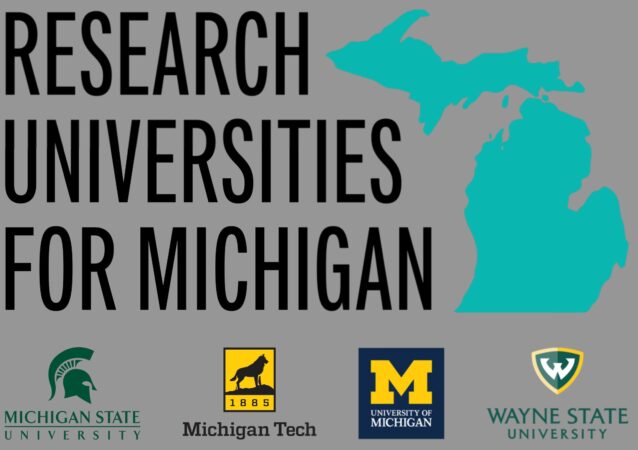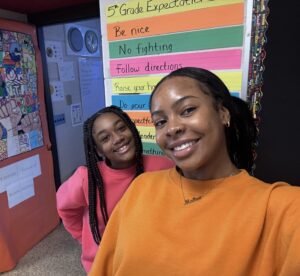Research Universities 4 Michigan (RU4M), formerly known as the University Research Corridor, unites the state’s four leading research institutions — Michigan State University, Michigan Tech, the University of Michigan, and Wayne State University. Together, these universities represent one of the most research-intensive coalitions in the nation, uniquely positioned to address the complex challenges at the intersection of environment, economy, and community.
This year, RU4M launched the Liveable Futures Initiative, a platform designed to catalyze collaborative, cross-disciplinary research that helps Michigan communities thrive in the face of climate change, flooding, pollution, and other sustainability challenges. The initiative fosters partnerships, funds seed projects, and accelerates innovation aimed at making Michigan — and the Great Lakes region — a global hub for sustainable solutions.
As a sponsor of the Sustainable Urban Design Summit (SUDS), RU4M is amplifying this mission, bringing academic research into conversation with practitioners, policymakers, and community leaders. Detroitisit spoke with Dr. Britany Affolter-Caine, executive director of RU4M, and Vince Nystrom, program director, about the power of collaboration, the role of research universities in Michigan’s sustainability journey, and the opportunities ahead.
REGISTER FOR SUSTAINABLE URBAN DESIGN SUMMIT 2025 , NOV, 6 AT NEWLAB DETROIT HERE.
How does RU4M’s collaborative model strengthen Michigan’s ability to tackle complex issues like climate resilience and sustainability?
Britany Affolter-Caine: Michigan is fortunate to have four of the nation’s highest-intensity research universities, and not every state can say that. Each brings deep expertise, but when we connect them, align agendas, and foster collaboration, the impact multiplies. Sustainability challenges — from climate change to clean water access — are too big for any single institution to solve alone.
That’s why we launched the Liveable Futures Initiative. It’s designed to seed and support collaborative research across institutions that directly addresses the issues shaping Michigan’s future: flooding, water quality, microplastics, algae blooms, and infrastructure resilience. It’s about creating solutions that make this state not just livable, but thriving, for generations to come.
How do you align the unique strengths of Michigan State, Michigan Tech, the University of Michigan, and Wayne State toward common goals?
Vince Nystrom: We start by mapping the research landscape in detail — tracking projects, funding, and outputs across institutions. Over the last five years, these universities have generated more than a billion dollars in sustainability research. By aggregating that data, we can see where expertise already overlaps and where it can be complementary.
For example, some universities are deeply invested in hydrogen research as a clean energy source, while others focus on water infrastructure or materials science. RU4M’s role is to connect these dots, highlight opportunities for collaboration, and make sure the state and industry partners know how to tap into this expertise when real-world challenges arise.
There’s often tension between environmental stewardship and economic growth. How does RU4M view this balance?
Affolter-Caine: For us, it’s not “either/or” — it’s the power of and. Sustainability and economic growth can reinforce one another if approached strategically. Take mobility: when new facilities are being built, like the Los Alamos-linked AI center in Ypsilanti Township, the conversation isn’t just about technology. It’s also about environmental standards, community impact, and long-term resilience.
Nystrom: At the research level, we see this duality all the time. Michigan State is testing bioreactors to reduce farm runoff. Michigan Tech is advancing natural resource management alongside engineering solutions. These projects protect the environment while building new industries, jobs, and opportunities.
Water is central to Michigan’s identity. What do you see as the most pressing water-related challenges, and how are universities helping address them?
Affolter-Caine: Flooding is a major one. Detroit has seen catastrophic flooding in recent years, and the Midland dam failure was another wake-up call. We need smarter infrastructure and policy solutions, and our universities are leading research on both fronts.
Microplastics are another urgent issue. Bills are moving through the Michigan Senate right now, and researchers are at the table providing science-based guidance. That’s where our role is so critical — connecting cutting-edge science with policy and practice.
Nystrom: Beyond urban flooding and water quality, there’s also a huge economic and ecological dimension. From rebuilding the Soo Locks to protecting outdoor recreation, water drives both industry and community life here. Universities are advancing technologies for oil spill prevention, fresh water protection, and agricultural water efficiency.
From your vantage point, what role will AI and advanced manufacturing play in tackling sustainability challenges?
Britany Affolter-Caine: AI is one of our verticals, and we’re seeing it play two roles. On the one hand, researchers are advancing AI itself as a technology. On the other, more and more teams are using AI as a tool to accelerate their own work. For example, when we faced the challenge of PFAS contamination, AI helped identify and map the many different compounds — short- and long-chain variants — much faster than traditional methods. That kind of pattern recognition and data processing makes it possible to reach solutions more quickly.
Vince Nystrom: What’s powerful about AI is that it operates both as a standalone sector and as an enabler across every other sector. Whether it’s mobility, clean energy, or water, AI is being embedded into research and development as a force multiplier. Advanced manufacturing works in much the same way — it provides the tools and methods that make scaling these innovations possible.
How are students being prepared to enter careers at this intersection of science, sustainability, and economic development?
Affolter-Caine: RU4M acts as a conduit, ensuring industry needs are reflected in university programs. We ask employers what skills they’re looking for, feed that information back into curricula, and track how students are graduating into these critical fields.
Nystrom: The entrepreneurial piece is also growing. Each university has accelerators, incubators, and programs that encourage students to build their own ventures. We’ve already seen spinouts ranging from advanced materials to clean-tech startups. In fact, one in five of our alumni become entrepreneurs — and many are now tackling sustainability challenges directly.
When you look ahead, where can Michigan lead most strongly in the global sustainability conversation?
Affolter-Caine: Water is where we have unmatched potential. Few regions in the world can rival Michigan’s freshwater resources or the scale of expertise we’ve built around them. At the same time, energy storage and clean mobility will be critical. But water innovation — quality, management, resilience — is where we can truly lead.
Nystrom: Michigan gets called the “Saudi Arabia of water.” That abundance comes with responsibility. If we manage it wisely, Michigan can set the standard globally for how water is protected, leveraged, and sustained for both economy and environment.
As always, be sure to subscribe to our newsletter for regular updates on all things Detroit.























